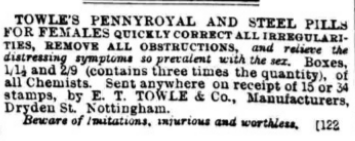The question of abortion rights has once again been in the news recently, with draconian legislation around a woman’s right to choose passed in a number of US States. Globally today, over 40% of women live in countries in which the right to abortion is heavily restricted. Evidence from the World Health Organisation suggests over 20 000 women lose their lives as a consequence of unsafe abortion each year.
The move to further criminalise abortion in the United States is a depressing and retrograde step in this respect, and one which is likely to result in an increase in this figure. Women have always exercised their right to terminate their pregnancies: legal abortion simply means they can do so (relatively) safely. Following the passing of legislation legalising abortion in Northern Ireland in 2019, women from any of the four UK nations can, in theory at least, access safe abortion. In Victorian Britain, though, this wasn't the case, and many women lost their lives in attempts to terminate their pregnancies.

Abortion was widely practiced in the nineteenth century: at a time when preventing pregnancy was difficult, abortion presented an often-welcome alternative to progressing with a pregnancy. Statistics are difficult to ascertain, as its criminal status meant it was inevitably concealed from public view, but the multitude of adverts for abortifacients, reports in newspapers of inquests and criminal trials involving abortionists, and occasional insights from women’s life writing all point to its widespread use.
Advice literature, which often included long lists of behaviours and substances believed to induce miscarriage, conversely might prove useful to women seeking to end a pregnancy. Many advice books implored women to avoid horse-riding in pregnancy, and in George Eliot’s Middlemarch (1871), Rosamond suffers a miscarriage after ignoring this advice. Whilst this account is fictional, there is evidence that some women attempted to end their pregnancies by subverting such advice. In 1806, the diarist Eugenia Wynne wrote of an acquaintance of hers who ‘talks coolly of riding hard to procure a miscarriage’. Other women took various concoctions, including penny royal, in attempts to end their pregnancies.
Abortion has long been associated with ideas of trauma, concealment and shame, and with the figure of the young, single woman, who resorts to a termination of her pregnancy out of desperation. Such associations emerge from cultures in which unmarried motherhood has been viewed as scandalous, but they continue to hold sway in contemporary debates around abortion, such as those currently raging in America.
Unmarried mothers – from Victorian England to twentieth-century Ireland – have often had particular reasons to desire an end to unplanned pregnancies, and these women figure heavily in the history of abortion. But abortion is, and always has been, employed by women from all walks of life as a solution to the problem of unwanted pregnancy. This was as true in the nineteenth century as it is now: many single women concealed their pregnancies and sought out means to induce miscarriage, but so too did many married women – from every class of society.
Evidence of this from Victorian Britain can be found in the case of Lady Henrietta Stanley. Lady Stanley was mother to nine children when she again became pregnant in Autumn 1847. Both she and her husband were upset at the prospect of having another child, and so she took steps to end the pregnancy, as she informed her husband in a letter: ‘A hot bath, a tremendous walk & a great dose have succeeded’, she wrote. Her husband’s response to this news expressed both concern and relief at her actions: ‘I hope you are not going to do yourself any harm by your violent proceedings[.] […] If however you are none the worse the great result is all the better.’ Both Lady Stanley and her husband appear to have viewed the matter from a practical perspective, in contrast to the public discourses around abortion, which frequently framed the issue from a moral perspective.
Many women, like Lady Stanley, successfully ended their pregnancies in nineteenth-century Britain, but, nonetheless, illegal abortions were risky: women couldn’t be sure that the substances they were taking to induce miscarriage were safe; abortions carried out using instruments, often by unqualified practitioners, risked damage and infection. Newspapers from the period carry multiple stories of women who died as a consequence of ‘illegal operations’ – and thus speak to the need for legal, accessible, and safe abortions.
The history of the practice of abortion is obscured, a consequence of its historic criminal status and association with ideas of shame, but it is not the traumatic history of young, single women that some assume it to be. Indeed, for many it has been – and continues to be – a practical and much-needed solution in a time of desperate need.
Jessica Cox, Reader in English Literature
Confinement: The Hidden History of Maternal Bodies in Nineteenth-Century Britain will be published by The History Press in 2023